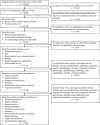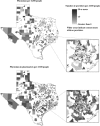Impact of Pharmacists on Access to Vaccine Providers: A Geospatial Analysis
- PMID: 30203603
- PMCID: PMC6131320
- DOI: 10.1111/1468-0009.12342
Impact of Pharmacists on Access to Vaccine Providers: A Geospatial Analysis
Abstract
Policy Points: Policymakers in the United States should consider expanding pharmacy practice laws to allow pharmacists to vaccinate adolescents as a way to improve geographic access to adolescent vaccines, particularly for human papillomavirus (HPV) vaccine, which has low uptake. Our state-level analysis showed that pharmacists are more geographically dispersed than primary care physicians in the US state of Texas. Including pharmacists among available adolescent vaccine providers would improve the geographic distribution of vaccine providers, especially in areas with an inadequate number of primary care physicians.
Context: The largest disparities in human papillomavirus (HPV) vaccination in the United States are due to geography. One potential way of addressing these disparities is by improving geographic access to HPV vaccination. Two federal panels have recommended including community pharmacists as HPV vaccine providers as a strategy to improve opportunities for HPV vaccination for adolescents. We sought to evaluate whether community pharmacists can improve the number of vaccine providers in areas with primary care physician shortages in the US state of Texas.
Methods: We gathered publicly available physician and pharmacist 2016 workforce data from the Texas Medical Board and Board of Pharmacy. We conducted geospatial analysis of census tracts to analyze the distribution of physicians and pharmacists and how pharmacists change vaccine provider coverage across the state.
Findings: Census tracts with high numbers of physicians per capita tended to be located near one another, in 5 of 5 analyses of Moran's I (median = .04). In contrast, pharmacist rates were not spatially dependent on census tract in any of our analyses. If pharmacists were added to primary care physicians as vaccine providers, 35% of urban census tracts that previously had inadequate coverage would be adequately covered, while 18% of inadequately covered rural census tracts would become adequately covered. Overall, when pharmacists were included with primary care physicians as vaccine providers, vaccine providers per capita increased in 2,413 of the 4,508 urban census tracts (54%), while the rate increased in 223 of 746 rural census tracts (30%).
Conclusions: Pharmacists are more geographically dispersed across census tracts than primary care physicians. As a result, adding pharmacists to the workforce would increase the availability of vaccine providers in areas with inadequate primary care provider coverage.
Keywords: HPV vaccine; access to health care; geographic factors; pharmacists.
© 2018 Milbank Memorial Fund.
Figures
Similar articles
-
Pharmacist insights into adolescent human papillomavirus vaccination provision in the United States.Hum Vaccin Immunother. 2019;15(7-8):1839-1850. doi: 10.1080/21645515.2018.1556077. Epub 2019 Feb 6. Hum Vaccin Immunother. 2019. PMID: 30550369 Free PMC article.
-
Are state laws granting pharmacists authority to vaccinate associated with HPV vaccination rates among adolescents?Vaccine. 2016 Aug 31;34(38):4514-4519. doi: 10.1016/j.vaccine.2016.07.056. Epub 2016 Aug 3. Vaccine. 2016. PMID: 27496275 Free PMC article.
-
Authority of Pharmacists to Administer Human Papillomavirus Vaccine: Alignment of State Laws With Age-Level Recommendations.Public Health Rep. 2018 Jan/Feb;133(1):55-63. doi: 10.1177/0033354917742117. Epub 2017 Dec 19. Public Health Rep. 2018. PMID: 29257933 Free PMC article.
-
Disparities in Healthcare Providers' Recommendation of HPV Vaccination for U.S. Adolescents: A Systematic Review.Cancer Epidemiol Biomarkers Prev. 2021 Nov;30(11):1981-1992. doi: 10.1158/1055-9965.EPI-21-0733. Epub 2021 Aug 23. Cancer Epidemiol Biomarkers Prev. 2021. PMID: 34426414 Free PMC article.
-
Human Papillomavirus Infection and Vaccination.J Pediatr Nurs. 2016 Mar-Apr;31(2):e155-66. doi: 10.1016/j.pedn.2015.10.005. Epub 2015 Nov 14. J Pediatr Nurs. 2016. PMID: 26586310 Review.
Cited by
-
Enrolling a rural community pharmacy as a Vaccines for Children provider to increase HPV vaccination: a feasibility study.BMC Public Health. 2021 Jun 29;21(1):1266. doi: 10.1186/s12889-021-11304-8. BMC Public Health. 2021. PMID: 34187438 Free PMC article.
-
Strategies for Disseminating and Implementing COVID-19 Vaccines in Rural Areas.Open Forum Infect Dis. 2021 Apr 2;8(6):ofab152. doi: 10.1093/ofid/ofab152. eCollection 2021 Jun. Open Forum Infect Dis. 2021. PMID: 34183979 Free PMC article.
-
Healthcare provider awareness, attitudes, beliefs, and behaviors regarding the role of pharmacists as immunizers.Hum Vaccin Immunother. 2022 Dec 30;18(7):2147356. doi: 10.1080/21645515.2022.2147356. Epub 2022 Dec 6. Hum Vaccin Immunother. 2022. PMID: 36472081 Free PMC article.
-
Pharmacist insights into adolescent human papillomavirus vaccination provision in the United States.Hum Vaccin Immunother. 2019;15(7-8):1839-1850. doi: 10.1080/21645515.2018.1556077. Epub 2019 Feb 6. Hum Vaccin Immunother. 2019. PMID: 30550369 Free PMC article.
-
Vaccine promotion strategies in community pharmacy addressing vulnerable populations: a scoping review.BMC Public Health. 2023 Sep 23;23(1):1855. doi: 10.1186/s12889-023-16601-y. BMC Public Health. 2023. PMID: 37741997 Free PMC article.
References
-
- Reagan‐Steiner S, Yankey D, Jeyarajah J, et al. National, regional, state, and selected local area vaccination coverage among adolescents aged 13–17 years—United States, 2015. MMWR Morb Mortal Wkly Rep. 2016;65(33):850‐858. - PubMed
Publication types
MeSH terms
Substances
Grants and funding
LinkOut - more resources
Full Text Sources
Other Literature Sources
Medical
Research Materials





